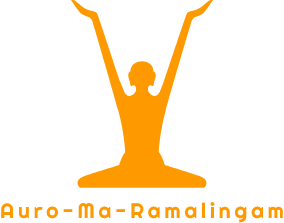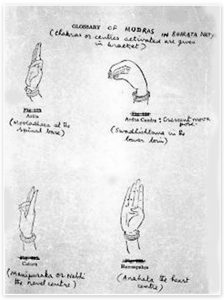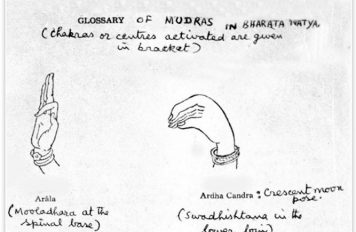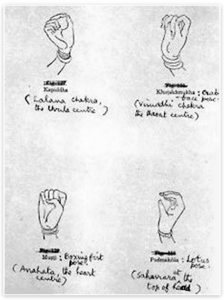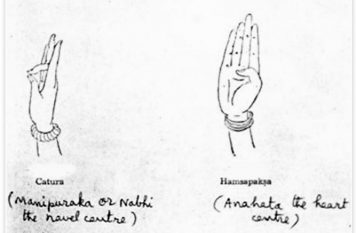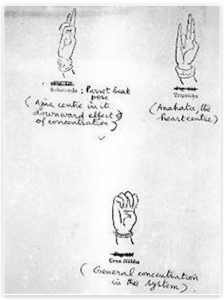YOGA OF MUSIC
APJA-GRACE LIGHT YOGA TECHNIQUE-
OF AWAKENING AND OPENING UP THE CHAKRAS (PSYCHO-PHYSICAL CENTRES IN THE MID-LINE OF OUR BODY)
THROUGH THE PRACTICE OF ‘YOGA OF MUSIC’, AS GIVEN BY THE ANCIENT SUPER YOGI, SAINT TIRUMOOLAR IN HIS TIRUMANDIRAM(SCIENCE OF SUPRAMENTAL TAMIL VEDAS).
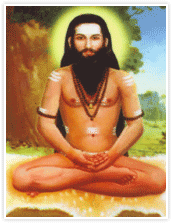

SRI T.R.THULASIRAM BRINGS TO LIGHT THE MOST PROFOUND AND SECRET RHYTHM OF THE FIVE POWERFUL VOWELS EVER REVEALED TO THE MANKIND, WHICH PUTS ONE INTO CONTACT WITH THE DIVINE DANCE OF TRUTH- VIBRATION AND SUPERMIND CONSCIOUSNESS.
Yoga of Music is mainly concerned with the seven musical notes and the five vowels that are usually rendered in Raga Alapana, and they evoke or activate the different Cbakras, the psycho-physical centres on the mid line of body. The yoga of music came into revelation recently because of the Spirit of Music becoming active on the eve of the Bi-centenary celebrations of Sri Venkata Ramana Bhagavathar, the great composer, singer and saint and worthy and faithful prime disciple of the great saint Thyagaraja and therefore it is dedicated at their holy Feet and to the Music world at large.
Tirumoolar, the well-known saint, sage and super yogi and Siddhar of South India in his book of Mantras called “Tirumandiram” (TM) declares ‘Anandam Anandam is the one. Anandam Anandam-A-I-U-E-OM the five centres. Anandäm means Bliss of the One Divine. The five main centres Or chakras that are respectively evoked and activated or opened by chant of the said five long vowels are as follows A-I-U-E-OM. (A) activates the spinal base or sex centre (Mooladhara), (I) the navel centre (Nabhi), (U) the heart centre (Hirudaya), (E) the throat centre (Kanta), (O) the mid- forehead centre (Ajna) and when O as chanted with M, i.e., as Om o rather as O… m…… it reaches and strikes at the top of the head i. e., the Sahasrara centre. Now these vowels are frequently used in the Ragas, with the musical syllables of Tada-Rira-Nna . To open a particular centre one has to repeat its vowel slowly and distinctly for some time, saying it twenty times or more (preferably with the loving and joyful remembrance of the one Divine). Then, after stopping its chant one may observe the place or centre where the impact of its vibration has reached of struck. Thus one may open the five chakras or centers by the respective five long vowels. The same five centres may be also opened by the corresponding short vowels, viz., A-I-U-E-O (being pronounced shortly). The chant of the five short vowels has an inward or inner impact of vibration at the five centers. The vowel (I) pronounced. in English as “I” of the first person evokes the uvula centre in the upper throat.
Now we come to the seven musical notes, Sapta Swaras or rather more appropriately to the eight notes especially from the yoga point of music. The eight musical notes, Sa, Ri, Ga, Ma, Pa, Da, Ni, Sa evoke the inner centers (chakras) on the mid line of the body. Thus Sa evokes the center in the spinal base, Ri in naval , Ga in lower abdomen(Swadhistana), Ma in heart, Pa in uvula, Da in mid-forehead, Ni in the top head(inwardly in its depth), and finally Sa in the same top center(but upwardly). Generally speaking, the rendering of musical notes in Tara Sthayi the upper octave leads the consciousness upwards, whereas Mandhara Sthayi the lower octave in the inward depth. Vowels and notes also give inward or outward consciousness at their centers according as they are pronounced short or long(dheerga) respectively. Notes with a stress of accent as in the eighth note Sa, give the upward consciousness. The variations of a particular note (for e g, Ni) evoke the same centre but in its different depths of inward consciousness. Even the chant of the name of a note (for eg., ‘Madhyamam”) activates the same centre as its note (Ma) does. So too, the cumulative and predominant effect at a particular center when rendering a raga may be known also by chant of its name, for e.g., Madhyamavati at the heart. Ragas also awaken their sentiments (rasas) which in turn touch the centers.
Musical notes are restricted during Raga Alapana to evoke the three main centres in the order of mid forehead – navel – top of head by employing their syllables Tada-Rira-Nna, and by staying on ‘na” frequently with a long, or. Short vowel of the letters a, i. u, e, o) (or om, ong) to make the Melody rich and entertaining. “Na” followed by a vowel makes the combined note flow from the top head. Tamil children too learn the alphabets by pronouncing with “na” – for e.g., ana, ina, una, tana, rina. nina …. so on. However, the cumulative effect of a Raga may be felt by the singer at a particular center like the heart or mid forehead. In Tanam the music flows mainly between two centres, the mid forehead and top head, because the distinct syllables employed are Tada-Nna (or Nam), and the two are combined in their various musical syllables to mean and sound ‘Tat Anantam” or “Tat AAnandam”. This reminds us again the mantra of Tirumoolar ‘ Anandam Anandam is the one. Anandam Anandam – A-l-U-E-Om.”
Musicians perhaps miss this important study of the yogic effect of musical notes, as they are mostly concerned with the technicalities of music, the tala and melody. Though the musical melodies and Ragas in their “Nava rasas” have their own charming, sweet and melting appeal particularly at the heart center, sometimes even with the soul-touch, the repetitive chant, of the five vowels or of the eight musical notes provide a direct, conscious and’ simple and effective method of activating all the centres in one and all. There was also the ancient practice of Sana Vedic chant of vowels. The chant and the effect of the vowel sounds as well as of the musical notes, syllables and phrases, can be consciously practiced and observed by the musicians leisurely at home and it can be also taught and imparted even to the school-going children without going into the technicalities of music. This will be the greatest education easily made possible even at that tender age and life becomes more meaningful only with the opening of the centers or at the least with their conscious activation by the fundamental practice of vowels, and the eight notes.
In Bharata Natya too, the stamping of foot in tune with the fundamental dance rhythm of Tha-Thi-Thai evokes the same three centres as the Raga rhythm of Tada-Rira-Nna. There are also different hand poses (mudras) which, by bending and straightening or joining the fingers evoke their. Respective chakras, besides giving concentration of conciousness in the upward, inward, outward and, downward directions. As in the case of five vowels, the five fingers too are connected by nerves with the five chakras, the forefinger with the spinal base, middle finger with the navel, ring finger with the heart, little finger with the throat, thumb with the mid- forehead. Similarly with the five toes. The facial expressions for the nine sentiments have also their impact on the respective centers. In fact all the five senses are connected with the chakras. The seven colours or colour lights, the six tastes of tongue, the different fragrances and the different kinds of Touch-sensation especially on the different points of genital organ have each its characteristic impact on a particular center only. However here we are mainly concerned with sound and music
Tirumoolar now proceeds to give (in TM 912) the most profound and secret rhythm of the five powerful vowels ever revealed to the mankind and which puts one into contact with the divine Dance of Truth-vibration – Kooththu. The mantra runs thus; “Kooththe- I -U-A-E-Om… Kooththe he-I-U-A-E-Om Kooththe-I-U-A-E-Om. In the last part of the mantra the long vowel I is changed into the short vowel I. Chant of this rhythm integrates and harmonizes the mind, heart, life and the senses, the nervous system and the body at all levels of one’s nature- outer, inner and the inmost and also the three bodies viz., the physical, subtle and causal and prepares the system as a whole effectively not only for the spiritual realization of soul, self and the Divine but also for transformation of one’s nature and body into a divinised perfect nature and golden body. By practice of this chant one actually observes in silence the slow but graceful dance – like leaping movements of consciousness from the depth of one centre to another in the said order of the five vowels. At its best this new and secret rhythm of vowels puts one also into contact with the divine Dance of the Truth-world of Supermind (Cidambaram or Cit Ambalam) and thereby brings the transforming divine Light, Bliss and Amrita into the system (Adhara) and even into the physical body.
Thus, the same vowels but given in two different rhythms or order in the said two mantras of Tirumoolar answer all the requirements of yoga, connecting also the music with the dance and that too with the divine Music and the divine Dance.
This yoga of music is meant not only for musicians or learners of music but also for all music lovers and connoisseurs of music and even for the learners of the musical dance-rhythms, because the link that connects them all is the same centres or chakras of yoga. In fact, music can be heard or rather received physically even by the open throat, the vocal chords of which vibrate in resonance with the radio-music of the singer. The Divine as Nada Brahmam, as Sound – Power of Manifestation, becomes real only with the opening of centres by the sound of vowels or of the musical notes, or otherwise by the said mantras.
T.R.Thulasiram
Pondicherry,
15-8-1981
By Courtesy to A. I. R.( All India Radio Station )
Pondicherry.
Note: Musicians or others who sing Swami Ramalingam’s Arutpa Songs of Grace- Light in concerts, are found to bear the Swami’s high Supramental power of grace in their body for, the power has evidently entered them through their throat centre. This is in a marked contrast with the far less power of those who sing Carnatic musical songs of saint Tyagaraja or other music of other saints.
For understanding the correct pronunciation of the above said musical vowels, please download and read the printed version of ‘Yoga of Music,’ in the free download section of this website.
